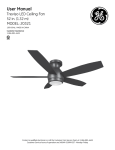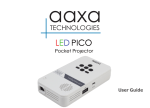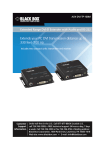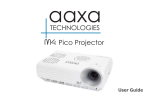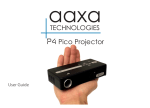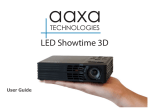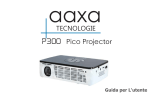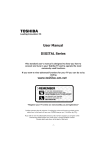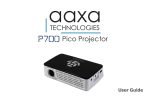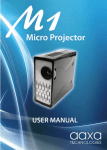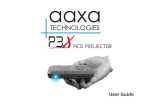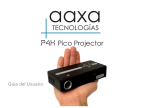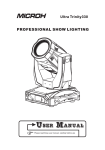Download User-Manual - CNET Content Solutions
Transcript
aaxa TECHNOLOGIES User Guide Quick Start Guide Step 4: Settings Button Step 1: Power Adapter Port Step 2: Power Button Step 3: Adjust Focus Step 1: Connect the power adapter Step 2: Press the Power button once, the fan should start spinning and the projector engine shoud light up Step 3: Adjust the focus as needed Step 4: Enter the “OSD” Menu to change brightness or to select inputs. The OSD Menu can be accessed via the “Settings” button on the projector or the “Menu” button on the remote control Caution! WARNING: Please use this product as instructed. Misuse may cause injury or death. DO NOT expose to water or wet surfaces. Electric shock may occur. DO NOT expose the projected LED image to your eyes or the eyes of others DO NOT block or restrict airflow from ventilation holes as this may cause the projector to overheat Keep the projector charger away from any heat sources Caution for Headphone Use • Prolonged use at high volume may impair your hearing. Table of Contents Chapter 1: Projector at a glance Main Unit Front/Back Remote & Keypad Accessories Chapter 2: Getting Started Powering On / Off Focus Adjustment / Throw Distance Accessing OSD Menu Adjusting the Brightness Picture Settings & Mode Connecting to Projector Enabling Video Output (on a laptop) Connecting to Composite Video 1 2 3 4 5 6 7 8 10 13 17 Connecting to VGA Connecting to HDMI Connecting to USB Connecting to Speakers & Headphones Chapter 3: File Playback Playing Videos Viewing Pictures Music Playback Video Playback FAQ Chapter 4: Android System Connecting to Wireless Quick Launch Buttons Apps Menu Office Files 15 16 17 18 20 22 24 26 28 30 31 33 Table of Contents (Cont) Wireless Display (Screen Mirror) Connecting to Bluetooth Display Settings Chapter 5: Settings Picture Configuration Keystone Adjustment 34 38 39 40 44 Chapter 6: Technical Details Trouble Shooting Specifications 47 49 LED Android at a Glance Chapter 1 Settings Button Navigation Pad Power Adapter Receptacle Back Button Power Button Focus Wheel Lens 3.5 mm Composite Jack 3.5 mm Audio Jack VGA Input HDMI Input USB Port Mini USB Port 1 Remote & Keypad Both the keypad and remote can be used to control the projector. The Main Menu Navigation on the remote functions similarly to the keypad on the projector but with additional features that include: 1. Mouse Pointer - The Mouse icon opens a mouse pointer on the screen. To enter “mouse mode” press the mouse icon on the remote control and press the left or right arrow key. The mouse pointer should begin to move. To exit “mouse mode” double-click the mouse icon. (Press Right / Left if it does not work immediately) 2. Volume Control - Use the volume keys to adjust the speaker volume 3. Keystone - Adjust the keystone manually with the remote control (vertical only) 2 Accessories A/V Cable Power Adapter Remote *Under various circumstances, the actual accessories may be different from those shown in the pictures above. 3 Getting Started Chapter 2 Powering ON the projector 1. 2. 3. Connect the power cord to the Projector Connect the opposite end of the power cord into a wall outlet. Press the POWER button on the top of the projector to start the projector or press the POWER button on the remote control to start the projector. * The POWER button’s blue LED light will turn on when the projector is on. Powering OFF the projector 1. Press the button on the keypad or remote twice to turn the projector off. The optical engine should power off and the fan should stop spinning. The projector can be turned on using the remote control. Power Socket 4 Focus Adjusment / Throw Distance Focus Adjustment Located on top of the projector, turn the focus ring to the left or right until the image becomes clear. Throw Distance Chart Diagonal inch (“) Min Max 19 28 38 47 56 66 75 150 Distance from Lens to Screen (“) 20 30 40 50 60 70 80 157 DIA GO NA LS CR EE NS IZE 16:9 Aspect Ratio Throw Ratio 1.22 *minimum throw distance: 20 inches 5 Accessing the OSD Menu The OSD Menu The OSD Menu allows the user to control 3 primary functions of the projector. (1) Input Selection (2) Brightness Settings (3) Picture Settings To Access the OSD Menu Simply press the “settings” button ( ) on the projector or the “menu” button on the remote control. The OSD Menu will pop up. 6 Brightness Settings Standard Mode The Projector operates at 450Lm in standard mode. Standard brightness is designed for a wide range of altitudes and ambient temperatures and preserves light-source life Boost Mode Boost Mode delivers 550Lm of brightness. The Projector is designed to run in boost mode for 60 minutes each time. Excessive use of Boost Mode will decrease light-source lifespan. To toggle “on” boost mode, simply select “Boost Mode” in the OSD menu. The fan will spin faster and the projected image become brighter. 7 Picture Settings Picture Mode The picture mode allows the user to select between different picture modes Dynamic, Standard, Mild, and Custom. The differences in each mode is a combination of changes in Contrast, Brightness, Color, Sharpness, and Tint. A fifth mode, “User” allows the user to manually adjust these settings. Color Mode The color mode allows the user to pick between Warm, Medium, and Cool color temperatures. The differences in each mode is changes to the Red, Green, Blue color-mix. A forth mode “user” allows the user to manually adjust the color-mix. 8 Picture Settings (Cont) Aspect Ratio The Aspect ratio can be set to 6 different settings. The first is an “auto” setting. The next few settings forces between 4:3 or 16:9 (native) aspect ratio, while Zoom 1 and Zoom 2 will zoom the image. “Just Scan” can switch the image to wide screen / cinema mode. Display Mode The Projector allows 4 different display modes which accomodate for rear-projection and reverse (up-side down) mounting and is accomplished through vertical or horizontal flip. Keystone Keystone allows vertical keystone adjustment. Please see Keystone Adjustments page for more information. Horizontal Keystone is not supported. 9 Connecting to the Projector HDMI - VGA - AV The Projector offers 6 different input sources. This section will focus on HDMI, VGA, and AV (Composite) input. Selecting Inputs The Input Selection menu can be found by accessing the OSD menu. The OSD menu is accessed by pressing the “Settings” ( ) button on the projector or the remote control. 10 Connecting to the Projector (Cont) To connect a device to the Projector first connect the appropriate source cable. HDMI is a full sized HDMI cable. VGA is a standard 25 pin VGA cable. Composite Video is the included 3.5mm AV cable. After connecting the cable open the OSD menu and select the appropriate format. For example to enable an HDMI connection first connect the HDMI cable then select “HDMI” in the OSD menu. 11 Connecting to the Projector (Cont) HDMI Connection When connecting to HDMI remember to set the output resolution to match the projector. The native resolution of the projector is 1280x800. Not all resolutions will match, please try a few different resolution settings to obtain the desired display. On systems like the Playstation 4, a safe-mode boot (on the PS4) may be needed to change the output resolution to match. VGA Connection VGA connections are analog connections without “autodetection”. To connect a laptop to the LED Projector first set the resolution. We recommend resolutions at or near 1280x800. Depending on your device, sometimes toggling the VGA output to “ON” is needed. Each laptop configuration is different, for example Function+F5 is sometimes used to toggle the VGA output On / Off on laptops. Please check your device owners manual for more detailed instructions. RCA Connection To connect Composite Video (RCA) connections simply connect the red, white, and yellow RCA cables to the included 3.5mm RCA cable. The 3.5mm port should then plug into the 3.5mm AV port of the LED Android Projector. 12 Tips: Enabling Video Output Step 1: To enable VGA or HDMI output on your computer most computers require “turning on” the video output feature. Each computer is different. Please consult your owner’s manual for instructions to enable VGA or HDMI output. Below are standard instructions for a Windows XP computer – not all systems are the same. Step 2: Press function & “F5” to instruct the computer to enable multiple displays. You can also press Windows+P to toggle through display settings. *NOTE: different operating systems may differ Step 3: 1.Right click on computer desktop and select “Properties” 2.Display Properties window will pop up 3.Click on the “Settings” Tab 4.If a secondary monitor is grayed out, click on it and check “Extend my Windows Desktop onto this monitor” 5.If the image is blurry or the text is not legible, adjust the screen resolution. We recommend 1280x800. 13 Tips: Connecting to Composite Step 1: Connect the 3.5mm A/V Cable to the back of the Projector. Step 2: Connect the composite end of the AV Cable (Red, White,Yellow) to your device. 14 Connecting to VGA Step 1: Connect one end of the VGA Cable to the back fo the projector and the other end to the source device Step 2: Select “VGA Input” in the OSD Menu of the Projector Step 3: Enable the video output of your source device. Frequently this is done with the function F5 key or by enabling “video output” in the “display settings”. Please see your device’s owners manual 15 Connecting to HDMI Step 1: Connect one end of the HDMI to your projectors HDMI Adapter Step 2: Select “HDMI Input” in the OSD Menu of the Projector Step 3: Connect the opposite end of the HDMI cable to your device. Note: Apple devices require a specialized HDMI adapter (Sold separately by Apple) 14 14 16 Connecting to USB The Projector features two (2) USB ports. One full-sized USB port and one mini-USB port. Both USB ports are full function USB ports and can either connect to a peripheral device such as a mouse or a USB memory stick. USB Memory sticks of up to 32GB can be connected. Note: To Enable the USB Host function on the mini-USB port, please go to Android Settings and uncheck “Connect to PC” (under Device->USB) and then check “USB Debugging” (in the Developer Options submenu.) 17 Connecting Speakers/Headphones Step 1: Connect your speakers/headphones to the projector’s speaker adapter. 3.5 mm cord Speaker Adapter Step 2: Ensure the power and volume on your speaker or headphones is turned on Step 3: Place the headphones on and enjoy! *CAUTION for Headphone Use • Prolonged use at high volume may impair hearing 18 File Playback Options Chapter 3 The Projector has 3 playback modes. These modes include Video playback, Picture Slideshow playback, and Music playback To connect content to the Projector use the USB port found on the back of the projector. The Projector can support USB sticks up to 32GB. Audio file formats supported: MP2, MP3, WAV, AAC, WMA Video file formats supported: AVI(H.264,DIVX,DIVX,XVID), rm,rmvb, MKV( H.264,DIVX,DIVX,XVID),WMV,MOV,MP4(.H.264,MPEG,DIVX,XVID),DAT(VCD), VOB(DVD),PMP,MPEG,.MPG,, FLV(H.263,H.264),ASF ,TS, TP,3GP,MPG Photo file formats support: JPG, JPEG, BMP, and PNG. 19 Playing Videos Video Player Selection • To Access the Video playback menu, in the main menu select the “Videos” icon. • In the Video Submenu you will see a preview of available videos. • Select the video you wish to play 20 Playing Videos (Cont) The Video Player • As your video begins to play you will find a playback control menu at the bottom of the screen which can be brought up by pressing the “UP” arrow • If you don’t see the control menu, press “UP” arrow on the projector or the remote control to bring up this menu • Volume Adjustment can be achieved with the remote control or in the menu • FFWD and RWD can be achieved by highlighting the progress bar Decrease Volume Bookmark Rewind Increase Volume Pause Fast Forward Full Screen Repeat 21 Viewing Pictures Picture Viewer Selection • To access the Pictures menu in the main menu, select the “Pictures” icon. • In the Picture Submenu you will see a preview of available pictures. • Select the picture you wish to view 22 Viewing Pictures (Cont) Picture Viewer There are several options for viewing pictures. These options include: • • • • Picture Slideshow - Bring up the settings menu and select SlideShow mode to begin the slideshow E-mail the picture - Bring down the options menu to be able to e-mail the picture Edit the picture - Bring up the photo editor (3 rings) to be able to edit the picture Rotate the picture - Bring up the settings menu to be able to rotate the picture Options Menu Photo Editor Settings Menu 23 Music Playback Music Player Selection • • • To listen to music select the Music Player option in the main menu In the Music Submenu you will see a preview of available Music. Select the video you wish to play 24 Music Playback (Cont) Decrease Volume Rewind Pause/Play Fast Forward Increase Volume 25 Video Playback FAQ How do I get rid of the bottom navigation bar? • The navigation bar will disappear automatically after 4 seconds My video refuses to play what do I do? • How does the “bookmark” function work? • Book-marking a segment of the video allows the user to return to that specific section of the video at a later time. Upon re-opening the file the user will be prompted if they want to return to the bookmark Not all file formats are compatible with the video player. Try encoding the video in another format. There are free converters such as “Format Factory” that can convert video files Stuck in the selection menu help! • Use the back button or the mouse to navigate outside of the selection menu. 26 Android System Chapter 4 The Projector features an Android Operating system based on a dual-core ARM chipset. The Android Operating system allows the user to download apps, surf the internet, stream movies, and a whole host of other features normally found on an Android device. 27 Connecting to Wireless STEP 1 Connecting to a Wireless Router • • • To Connect to a Wireless Router first access the settings menu Select the WIFI settings submenu Ensure WIFI is turned “ON” STEP 2 Connecting to a Wireless Router • Select the appropriate router • Enter your passphrase to connect to the router Note: The WIFI connection works best with WPA connections. If you are using a WEP connection we recommend switching 28 Connecting to Wireless (cont) Settings Menu An alternative method to configure the wireless connection is to directly access the settings menu. The settings menu can be found by clicking in the “settings” Application in the Apps menu. In the settings menu turn on WIFI and select the correct router. After entering the password you should be connected automatically to your router. Note: Router and WIFI connection issue trouble shooting is beyond the scope of this manual. For problems connecting to a router we suggest contacting your router manufacturer or searching the internet for “Troubeshooting WIFI for Android” 29 Quick Launch Short-Cuts Depending on the region the Projector includes some quick-launch short-cuts. For the United States region these short-cuts include: Youtube - Youtube Link, Netflix - Netflix Link, HULU - Hulu Link, Google Google Link, Facebook - Facebook Link Note: For better performance we recommend downloading the respective Apps through the Google App store 30 Apps Menu The Projector allows accessing Android Apps via the Apps menu. Android Apps are different application software created by 3rd party vendors for various different uses and functions. Popular apps include streaming video clients, productivity apps (such as spreadsheets), and games. Access the Apps menu from the main menu. To launch an app simply click on the desired app. 31 Apps (cont) DOWNLOAD APPS There are two ways to download and install new applications. 1. The easiest is using the Google Play Store. Simply sign onto the Google Play store, search for your application and click “install”. The application will automatically install on the projector. 2. Another method is to download application and use the APK installer. You can also download your non-google sponsored applications directly from a variety of internet sources. After downloading the .apk file use the APK installer to install the app 32 Viewing Office Files The LED Android has the ability to view Microsoft Office files including Word, Excel, Powerpoint, as well as Adobe PDF files. There are a variety of free viewers and editors available through the Google Play Store such as Kingsoft Office. Note: Download a free viewer before attempting to view these files Download a viewer / editor through the Google Play store. We highly recommend a keyboard or mouse to edit MS Office or PDF files 33 Wireless Display SCREEN MIRRORING The LED Android allows wireless mirroring of Android Phones to the Projector. While wireless mirroring is not the most efficient connection for high bandwidth screen-sharing and is thus not recommended for videos and gaming it is a great option for most types of presentations. The WIFI display app is preloaded in your LED Android projector. You can find the App in the Apps section. 34 Wireless Display (Cont) Projector Smartphone Step 1: Projector - Open the WIFI Display app found in the apps section. Configure the name as needed Step 2: Projector - Click on the Search Feature Step 3: Smartphone - In the “Settings” section of the smartphone locate the “Display” settings and then turn on “Wireless Display”. On some phones this may be named differently such as “Screen Sharing”. Typically it is nested Settings > Display > Wireless Display 35 Wireless Display (Cont) Step 4: Smartphone - Turn on the wireless display feature Step 5: Smartphone - Click “Search for Displays”. After a few seconds the projector name should appear Step 6: Smartphone - Click on the Projector. Wait until connected Step 7: Projector - The Smartphone should appear on the bottom left hand corner of the WIFI Display App Notes: If connection fails try rebooting your phone and/or projector. To exit press the “back” button on the projector 36 Connecting to Bluetooth The Projector has a built in bluetooth chipset. This allows the connection of wireless controllers or wireless speakers and other bluetooth enabled devices. To connect to bluetooth device access the Bluetooth setup menu under the settings menu. Ensure Bluetooth is turned on. Once turned on Bluetooth is discoverable. All devices must be “paired” before using. 37 Bluetooth (cont) PAIRING DEVICES An alternative method to connect and pair a bluetooth device is to use the main settings menu. Under the bluetooth settings menu you will have a few options. 1. Make your device searchable - Click on “Only Visible to paired devices”. The projector will then be searchable to all bluetooth devices for two minutes. 2. Search for Devices - Click on “search for devices to identify new available devices Note: Bluetooth devices often pair differently. Please read your device owner’s manual to identify the best method to pair your device 38 Display Setting The Display Setting allows the adjustment of the size (stretch) of the screen both vertically and horizontally Vertical Stretch Use the up and down arrows to vertically expand or compress the image. Horizontal Stretch Use the right and left arrows to horizontally expand or compress the 39 Picture Configuration Chapter 5 The Picture Configuration can be accessed through the OSD menu. Click the “menu” button to enter the OSD menu. Under the OSD Menu select “Picture Adjust” Picture Mode • Changes the pre-selected picture mode Color Temperature • Adjusts the color temperature from hot to cool (red to blue). Aspect Ratio • Changes the aspect ratio of the picture - 4:3, 16:9* Display Mode • Allows the user to flip the image both vertically and horizontally Keystone • Allows the user to change the Keystone settings 40 Picture Configuration (cont) Picture Mode Picture mode can be toggled between User, Dynamic, Standard, and Mild. In User mode Contrast, Brightness,Color, and Sharpness can be set by the user projector, which affects the sound signature. Color Temperature Color Temperature can be toggled between Cool, Medium, Warm, and User. In User mode Red, Green, and Blue saturation can be selected individually. 41 Picture Configuration (Cont) Aspect Ratio The aspect ratio of the image can be adjusted. The native aspect ratio is 16:9. Auto - Automatic aspect ratio 16:9 - Native Aspect Ratio 4:3 - Traditional Aspect Ratio Zoom 1 - Zoom in Zoom 2 - Zoom in Just Scan - 1:1 Pixel Ratio Panaromic - Panaromic Aspect ratio 42 Picture Configuration (Cont) Display Mode The display mode allows the user to flip the image both vertically and horizontally. This allows for ceiling mounting and rear projection. For example to achieve rear projection select “horizontal flip” and the image will be flipped 180 degrees on the Y-Axis. To achieve ceiling mount select “vertical flip” and the image will be flipped 180 degrees on the X-Axis. The display mode is “remembered” upon power-off. 43 Keystone Adjustments What is Keystoning? “Keystoning” occurs when a projector is aligned non-perpendicularly to a screen, or when the projection screen has an angled surface. The image that results from one of these misalignments will look trapezoidal rather than square. Digital Keystone Adjustments By adding a special, selectable, algorithm to the scaling, some new projectors are able to alter the image before it reaches the projection lens. The result is a squared image, even at an angle. 44 Keystone Adjustments Automatic Keystone Adjustment Automatic Keystone adjustment is enabled through a levelsensor on the projector. As the projector is tilted the image is automatically scaled to match the angle / degree of tilt. This feature is turned “on” from the factory. Manual Keystone Adjustment Users can choose to adjust the keystone themselves to match circumstances where the automatic keystone adjustment is ill-suited. This can be achieved by selecting “manual” in the Keystone adjustment submenu found in the OSD menu. No Keystone Adjustment Keystone adjustment can be turned off through the Keystone submenu. Note: Only vertical Keystone Adjustment is available (horizontal is not) 45 Keystone Adjustments FAQ How to Correct Keystone • If the image looks trapezoidal with the base larger (as pictured right), press the bottom button on the directional pad on the top of the LED Showtime until the keystone effect corrects and the picture turns into a square projection. • If the image looks trapezoidal with the top larger (as pictured right), press the top button on the directional pad on the top of the LED Showtime until the keystone effect corrects and the picture turns into a square projection. 46 Chapter 6 Technical Details Troubleshooting IMAGE IS BLURRED Possible Causes Solution The Projector is not in focus Adjust the focus with the focus adjustment dial until the image comes into focus The Projector is offset from plane / angle of operation Move the projector so that it is both 180 degrees and on an evern plane with the screen. No Sync, No Signal Be sure to setup the computer to enable a video signal output. On some laptops this is done by pressing and holding Function F5 key. If using the LED Showtime as an external monitor on Windows based systems, this can be done by selecting “extend my desktop to this monitor”. The native resolution of the LED Showtime projector is 1280x800. Depending on the video driver different resolutions may need to be selected for proper output. 47 Technical Details Troubleshooting THE PROJECTOR DOES NOT TURN ON Possible Causes Solution There is no power Check to ensure the power outlet source is good. check the power adapter to ensure a proper connection with the wall outlet as well as the proejctor. The power button was not held long enough To power on the projector, the power button needs to be depressed for a full 3 seconds. try holding the power button until the optical engine turns on NO PICTURE / FILE NOT SUPPORTED Possible Causes Solution The video source is not properly connected or selected Check the video source signal to ensure that it is properly connected. Select the current input source by choosing the input desired from the main menu Incorrect file extension / Video is encoded with incorrect codec Please refer to “Specifications” page to see which file types and codex are supported. Verify that the file was encoded properly. 48 Specifications Brightness: Native Resolution: Maximum Resolution: Aspect Ratio: Contrast Ratio: Projectoin Lens: Image Size: Lamp: 550 Lumens 1280x720 (720P) 1920x1080 (1080P) 16:9 2000:1 Manual Focus 10~160 inches Triple RGB LEDs with Vibrant Color Technology Life 20,000 hours Android OS: Processor (CPU): Internal Memory: Video in: Android 4.2 Dual Core Android 4.2 Processor 1GB DDR RAM Composite A/V VGA HDMI Audio Output: 2.0 W stereo speakers 3.5 mm audio jack Onboard Memory: USB: 4GB Internal Storage USB Host (Memory Sticks) Dimensions: Weight: Supported File Formats 5.9” x 5.2” x 1.4” 1.5 lbs AVI, MPG, MP4, MP3, FLV, RMVB, RM, JPG 49 Notes 50 Please direct all customer service inquiries to: AAXA Technologies, Inc. 1541 Parkway Loop Tustin, CA 92780 (714) 957-1999 [email protected]
























































